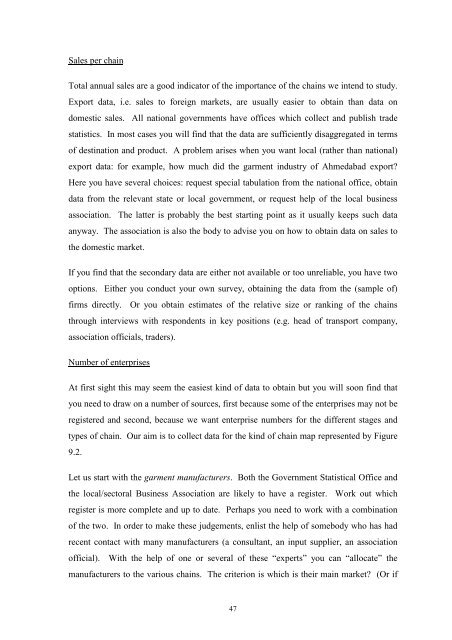McCormick+Schmitz Handbook for value chain research on - PACA
McCormick+Schmitz Handbook for value chain research on - PACA
McCormick+Schmitz Handbook for value chain research on - PACA
You also want an ePaper? Increase the reach of your titles
YUMPU automatically turns print PDFs into web optimized ePapers that Google loves.
Sales per <str<strong>on</strong>g>chain</str<strong>on</strong>g><br />
Total annual sales are a good indicator of the importance of the <str<strong>on</strong>g>chain</str<strong>on</strong>g>s we intend to study.<br />
Export data, i.e. sales to <str<strong>on</strong>g>for</str<strong>on</strong>g>eign markets, are usually easier to obtain than data <strong>on</strong><br />
domestic sales. All nati<strong>on</strong>al governments have offices which collect and publish trade<br />
statistics. In most cases you will find that the data are sufficiently disaggregated in terms<br />
of destinati<strong>on</strong> and product. A problem arises when you want local (rather than nati<strong>on</strong>al)<br />
export data: <str<strong>on</strong>g>for</str<strong>on</strong>g> example, how much did the garment industry of Ahmedabad export?<br />
Here you have several choices: request special tabulati<strong>on</strong> from the nati<strong>on</strong>al office, obtain<br />
data from the relevant state or local government, or request help of the local business<br />
associati<strong>on</strong>. The latter is probably the best starting point as it usually keeps such data<br />
anyway. The associati<strong>on</strong> is also the body to advise you <strong>on</strong> how to obtain data <strong>on</strong> sales to<br />
the domestic market.<br />
If you find that the sec<strong>on</strong>dary data are either not available or too unreliable, you have two<br />
opti<strong>on</strong>s. Either you c<strong>on</strong>duct your own survey, obtaining the data from the (sample of)<br />
firms directly. Or you obtain estimates of the relative size or ranking of the <str<strong>on</strong>g>chain</str<strong>on</strong>g>s<br />
through interviews with resp<strong>on</strong>dents in key positi<strong>on</strong>s (e.g. head of transport company,<br />
associati<strong>on</strong> officials, traders).<br />
Number of enterprises<br />
At first sight this may seem the easiest kind of data to obtain but you will so<strong>on</strong> find that<br />
you need to draw <strong>on</strong> a number of sources, first because some of the enterprises may not be<br />
registered and sec<strong>on</strong>d, because we want enterprise numbers <str<strong>on</strong>g>for</str<strong>on</strong>g> the different stages and<br />
types of <str<strong>on</strong>g>chain</str<strong>on</strong>g>. Our aim is to collect data <str<strong>on</strong>g>for</str<strong>on</strong>g> the kind of <str<strong>on</strong>g>chain</str<strong>on</strong>g> map represented by Figure<br />
9.2.<br />
Let us start with the garment manufacturers. Both the Government Statistical Office and<br />
the local/sectoral Business Associati<strong>on</strong> are likely to have a register. Work out which<br />
register is more complete and up to date. Perhaps you need to work with a combinati<strong>on</strong><br />
of the two. In order to make these judgements, enlist the help of somebody who has had<br />
recent c<strong>on</strong>tact with many manufacturers (a c<strong>on</strong>sultant, an input supplier, an associati<strong>on</strong><br />
official). With the help of <strong>on</strong>e or several of these “experts” you can “allocate” the<br />
manufacturers to the various <str<strong>on</strong>g>chain</str<strong>on</strong>g>s. The criteri<strong>on</strong> is which is their main market? (Or if<br />
47














